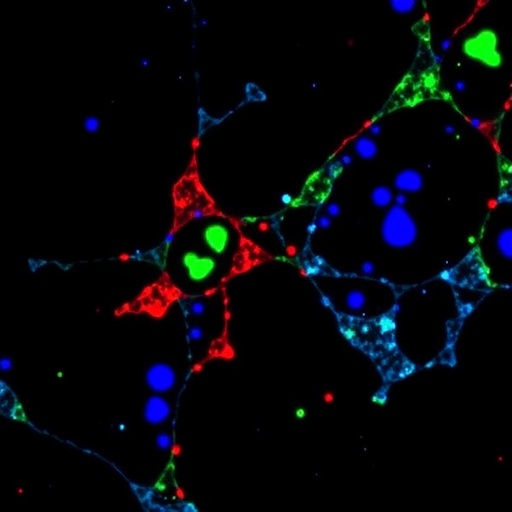In the intricate world of cellular biology, the ability to manage transcription under duress, particularly following DNA damage, is paramount for cell survival. While the processes that lead to transcriptional silencing in response to DNA damage have been extensively documented, the mechanisms that facilitate the resumption of transcription remain less illuminated. A recent study sheds light on this crucial aspect, revealing a novel function of poly(ADP-ribose) polymerase 1 (PARP1) in the transcriptional restart phase of the DNA damage response (DDR). This research unpacks the concept of poly(ADP-ribose)-mediated stabilization (PARSTA), specifically showcasing how PARP1’s interaction with the transcriptional coactivator AFF1 could be pivotal in the transcriptional landscape post-DNA damage.
The research unveils that upon encountering DNA damage, PARP1 engages with AFF1—a protein known for its role in transcriptional regulation. The binding of PARP1 to AFF1 is not merely decorative; it triggers a modification process known as PARylation. This post-translational modification serves to shield AFF1 from a process called ubiquitination, which typically marks proteins for degradation. By preventing ubiquitination, PARP1 ensures that AFF1 remains stable and functional, ultimately fostering the cell’s ability to resume transcription efficiently after it has been interrupted by damage.
This revelation about the role of PARP1 extends our understanding beyond its traditional functions that link it to DNA repair. Previously, PARP1 was celebrated primarily for its involvement in detecting DNA lesions and recruiting repair machinery. However, this new insight suggests that PARP1 may also orchestrate the recovery of transcriptional activity, thereby playing a dual role: repairing damaged DNA and facilitating the restoration of gene expression. This complex interplay underscores the sophisticated regulatory networks that cells employ to maintain homeostasis in the face of genetic insults.
The implications of these findings are significant, particularly in the context of diseases characterized by aberrations in DNA repair mechanisms. For example, cancer cells often exhibit elevated levels of PARP1 activity, a trait that has been exploited in targeted therapies. The study identified that cells resistant to genotoxic stress display not only heightened PARP1 activity but also increased levels of AFF1. This correlation underscores the potential for harnessing the PARSTA pathway as a therapeutic target, particularly in malignancies where hyperactive PARP1 contributes to tumor survival and therapeutic resistance.
Moreover, the research highlights the consequences of AFF1 depletion. The experimental results indicate that when AFF1 levels are diminished, cells exhibit reduced proficiency in repairing DNA damage and subsequently face increased rates of cell death. This finding raises important questions regarding the balance of transcriptional regulation during cellular stress responses. How do cells navigate the fine line between halting transcription to protect genome integrity and re-engaging transcriptional programs to restore cellular functions? Understanding this delicate equilibrium could pave the way for novel therapeutic approaches that modify gene expression patterns in diseases where transcriptional recovery is compromised.
The exploration of the roles of PARP1 and AFF1 opens avenues for a deeper investigation into the regulatory mechanisms that govern transcriptional activity in the context of DNA damage. The research indicates that the PARSTA mechanism is not an isolated process but rather part of a broader network involving multiple players in the DDR. The interaction between proteins involved in the stabilization and regulation of transcription raises the intriguing possibility that additional factors may also modulate the balance between transcriptional silencing and recovery, warranting further exploration.
As research continues to unfold, one can envision the potential for pharmacological agents that target the PARSTA pathway. Such therapies could enhance the mortality of cancer cells by disrupting their ability to recover from DNA damage. Additionally, these strategies might sensitize tumors to existing chemotherapeutic agents that induce genotoxic stress, amplifying their therapeutic efficacy.
The study also brings forth the notion of cellular resilience. Cells that can effectively manage transcriptional resumption post-DNA damage not only survive better but also adapt more efficiently to their environments. This resilience is essential for maintaining tissue function during periods of stress and could have wider implications in understanding aging, stem cell biology, and tissue regeneration. Further research in this domain could offer insights into how transcriptional recovery pathways might be modulated to enhance tissue repair mechanisms following injury or in degenerative diseases.
In summary, the newly discovered role of PARP1 in the transcriptional recovery phase post-DNA damage signifies a substantial addition to our understanding of cellular stress responses. The PARSTA mechanism highlights how cellular machinery can be reprogrammed to ensure survival and adaptability in the face of genomic threats. As we continue to delve deeper into the complexities of these processes, we are reminded of the intricate choreography of molecular players that govern life at the cellular level.
The findings reported in this study pave the way for future inquiries into the multifaceted roles of PARP1 and AFF1 in transcriptional regulation under stress. With continued exploration, the therapeutic potential of targeting the PARSTA pathway may soon translate into strategies that can combat diseases marked by dysregulated DNA repair and transcriptional control.
In conclusion, the elucidation of the PARP1-AFF1 interaction and its implications for transcriptional recovery highlights the need for a paradigm shift in how we view cellular responses to DNA damage. This study not only broadens our understanding of the DNA damage response, but also opens new doors for innovative treatments targeting the machinery of cellular resilience.
Subject of Research: The role of poly(ADP-ribose) polymerase 1 (PARP1) in transcriptional restart after DNA damage.
Article Title: Stabilization of AFF1 by PARylation ensures transcriptional restart after DNA damage.
Article References:
Zhu, F., Fu, H., Zhu, W. et al. Stabilization of AFF1 by PARylation ensures transcriptional restart after DNA damage.
Nat Chem Biol (2025). https://doi.org/10.1038/s41589-025-02045-5
Image Credits: AI Generated
DOI: https://doi.org/10.1038/s41589-025-02045-5
Keywords: PARP1, transcriptional recovery, DNA damage response, AFF1, PARylation, cellular resilience, therapeutic potential, gene expression.
Tags: AFF1 stabilization mechanismscellular mechanisms of transcription restartcoactivators in gene expressionDNA damage response pathwaysDNA repair and transcriptional silencingimplications for cancer therapiesPARylation and transcription recoverypoly(ADP-ribose) polymerase functionspost-translational modifications in cell biologyrole of PARP1 in transcriptiontranscriptional regulation after DNA damageubiquitination and protein stability





